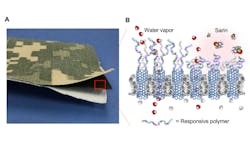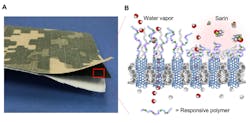Carbon Nanotubes Increase the Effectiveness and Comfort of Protective Clothing
Soldiers, healthcare workers and other first responders often face environmental unknowns, such as chemical weapons or COVID-19. Unfortunately, even state-of-the-art protective clothing does little to prevent contact with harmful chemicals and biological agents. For example, the clothing material must be breathable and let water vapor from the wearer’s body escape to prevent heat stress and exhaustion, but the clothing includes protective adsorbents or barrier layers that prevent it from being breathable.
To provide these workers with better protection, a team of researchers at Lawrence Livermore National Laboratory developed a “smart,” breathable fabric that also fends off biological and chemical warfare agents. Material of this type could be used in clinical and medical settings as well.
“We created a smart material that is both breathable and protective,” says scientist Francesco Fornasiero. “It combines a membrane layer with trillions of aligned carbon-nanotube pores and a threat-responsive polymer layer grafted onto the membrane surface.”
The carbon nanotubes are graphitic cylinders with diameters less than 1/5,000th the width of a human hair. They can easily let water molecules move in or out while blocking biological threats that do not fit through the pores.
Water vapor moves through the carbon nanotubes faster as the tube diameters get smaller. This surprised the development team and implies that single‐walled carbon nanotubes acting as moisture-conducting pores. It eliminates the compromise between breathability and protection that must be made when using other porous materials. That lets fabrics have more selective pores and still have a high level of breathability by using smaller-diameter carbon tubes.
Unlike biological agents, chemical threats are smaller and can fit through the nanotubes. So, to provide protection against chemical hazards, a layer of polymer chains is grown on the surface of the material that reversibly collapses when the chemical agents touch them, thus temporarily blocking the pores. These polymer chains were designed to collapse on contact with organophosphate threats, such as sarin.
The team showed that the responsive membranes have enough breathability in their open-pore state to meet the sponsor requirements. In the closed state, the ability of attacking chemicals to penetrate the is reduced by two orders of magnitude. These capabilities should translate into more comfortable and effective protective gear that can be worn for longer periods, whether in a hospital or battlefield.
In the next phase of the project, the team’s goal is to add on-demand protection against other chemical threats and make the material stretchable for a better fit, thus more closely mimicking the human skin.


